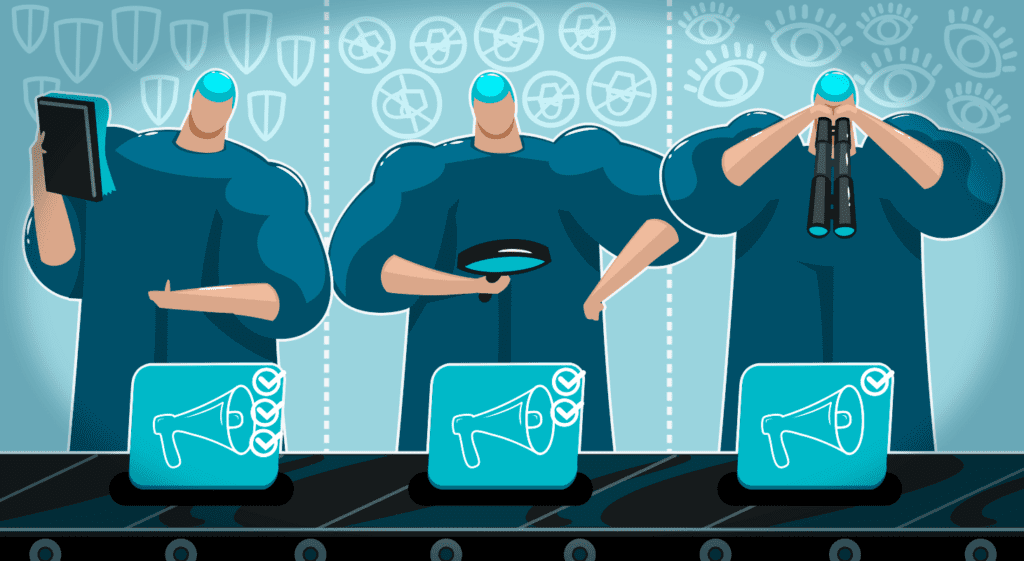What is Ad Verification and How It Boosts Advertising Efficiency?
In the rapidly evolving digital advertising ecosystem, maintaining the quality, transparency, and trustworthiness of ad placements has become a top priority for publishers. Ad verification is a critical tool in achieving these goals. It ensures that ads are displayed in the right context, reach the intended audience, and comply with industry standards—ultimately protecting publishers’ reputations and maximizing revenue.
This article will explore everything you need to know about the role of ad verification programs in maintaining trust in programmatic advertising.
What is Ad Verification?
Digital advertising has evolved over time. Nowadays, there are numerous automated platforms for ad serving. As a result, ensuring that ads are the right fit for a website and keeping them from being hijacked are harder than ever. That’s where ad verification comes in.
Although there are various forms of ad verification, it’s essentially the process of:
- Distinguishing real impressions from fake ones
- Monitoring ad placement for visibility and appropriate placement
- Spotting “malvertising” (malware hidden in or pretending to be an ad)
Verification can be performed by both advertisers and publishers. In fact, it’s essential for both to secure trustworthy reputations.
How Does Ad Verification Work?
Ad verification takes place in a dedicated monitoring channel. Each ad has a number of verification tags that allow to monitor things like:
- Places where the ad is published
- Specific placement on a host domain
- Host website content
- Rate of impressions
- Overall ad visibility
These are then used to assess traffic quality. Ad verification is often performed by impartial third-party providers with established processes for checking ad validity.
These third parties use many tools, such as APIs, algorithms, and adaptive machine learning models, to concretize ad verification solutions. With their platforms, publishers and advertisers can gauge the integrity of an ad and the site hosting it, their performance, and whether either has fallen prey to fraudulent activity.
The insights provided by these third parties help to decide whether an ad is well-placed and appropriate, as well as inform future decisions regarding content. An inappropriate ad placed on your website could lead to a PR nightmare and loss of revenue—but more on that below.
It’s also worth noting the growing impact of AI on ad verification and the difference between artificial intelligence vs machine learning in this context.
Third-party platforms leverage AI to mimic user behavior that helps identify irregular patterns common with bots. Machine learning learns from historical patterns to analyze vast amounts of data. Together, they help to more accurately classify ads, assign websites brand safety scores, and detect click fraud on a bigger scale.
Why is Ad Verification Needed?

Source: Statista
As you can see above, the estimated global cost of digital advertising fraud was $84 billion USD in 2023. It’s projected to surpass $172 billion by 2028. As ad hijacking and fraudulent impressions get more common, impartial ad verification is becoming an increasing necessity for multiple reasons.
Reputation
The importance of ad verification for both publishers and advertisers cannot be understated, especially from the perspective of brand safety.
It’s essential for publishers to protect their reputations. Ad verification allows you to safeguard your ad space from inappropriate or harmful content advertising controversial services or products. You don’t want your brand message compromised by irrelevant or bad ad content.
Ad verification allows you to steer away from ill-fitting ads and make sure what fills your ad space aligns well with your own content and possibly even strengthens your brand.
On the side of advertisers, ad verification is vital for them to protect the legitimacy of their ads. Just as you want to host ads that are safe and relevant to your content, advertisers want to place ads on websites with a solid reputation and related, appropriate content. Ad verification allows them to ensure this is the case.
Of course, ad verification also helps to foster a positive publisher–advertiser relationship.
Fraud and Fake Traffic Detection
We’ll explore this in more detail below, but ad verification tools can detect and block ad fraud, such as click fraud (fake clicks being generated to inflate costs) and impression fraud (where fake impressions are counted).
If this fraudulent activity remains undetected, it will harm the reputation and safety of your site as an ad hosting space.
For advertisers, unidentified fake traffic can be just as devastating. It impacts their performance metrics and renders their analyses useless. If unaware that the traffic is not genuine, advertisers could end up developing an entire ad campaign based on inaccurate analysis results, wasting both time and effort.
Revenue
As we’ve explained, ad verification offers a proactive way of overcoming or fully avoiding the issues surrounding inappropriate, controversial, and irrelevant ads appearing on your website and damaging your reputation. It also allows you to identify fraudulent activity, strengthening your position as a safe and trustworthy website on which to host ads.
Ultimately, this will attract advertisers and help you protect and increase your revenue. Hosting ads that are relevant and even interesting or helpful for your audience is also a great way to increase website traffic.
Not all types of programmatic advertising allow the advertiser to see where their ads have been—those that do (such as programmatic guaranteed) can be more expensive. With ad verification, advertisers with more limited budgets can ensure their ads are appearing on the right websites (which benefits you also) without having to spring for a more comprehensive plan.
As mentioned above, fake traffic can interfere with their metrics and skew ad campaigns. Once again, ad verification lets them identify this and correct it, if not avoid it altogether. In this way, they don’t waste their advertising budget and efforts.
What Does Ad Verification Detect?
Just like the nature of ad fraud and misuse, ad verification is a multifaceted concept. Here are the different elements a verification provider can help you detect:
Viewability
Poor publisher quality isn’t always about the threat of ad fraud. Sometimes, it’s about the placement and visibility you can offer. Ad viewability is incredibly valuable to advertisers. As such, you must ensure your website offers optimal ad viewability (ideally above 70%).
Ad verification platforms provide insights such as viewability rates that allow you to optimize your rates and delivery.
Fraudulent Activity
Fraudulent ad activity encompasses a wide range of practices, including:
- Ad stacking and pixel stuffing: Scammers layer multiple ads or clickable buttons under the targeted ad. Even though a user can’t see the ads beneath the one they’ve tried to click on, this practice successfully creates impressions for all of them. As well as stealing impressions, this can expose potential customers to unsafe websites.
- Bot fraud and attribution manipulation: Bot fraud is used to inflate ad engagement, while attribution manipulation influences or alters the conversion event, leading to increased spending for advertisers and decreased trustworthiness for publishers.
- Ad and click hijacking: Ad hijacking uses malware to replace an ad in a legitimate slot with scam links to steal revenue or personal information. Click hijacking targets interested users by redirecting their clicks to different destinations (such as an invisible link to a fraudulent site).
- Location masking: Geo-tracking is an important tool for filtering data that is geographically irrelevant. Location masking feeds you useless data by falsifying its origin.
Contextual Brand Safety
Remember that all-important brand safety we explored above? Ad verification platforms will use APIs and analytics to determine whether ad and site content are safe and align.
For instance, an advert praising Large Language Model features like word embeddings and tone analytics wouldn’t do well on an AI-critical article page due to the risk of negative engagement, despite the main topic at hand being the same
The Main Ad Verification Vendors
As with many B2B solutions, there are plenty of options on the market. To give you a starting point, here’s a quick rundown of several ad verification vendors to consider:
1. DoubleVerify
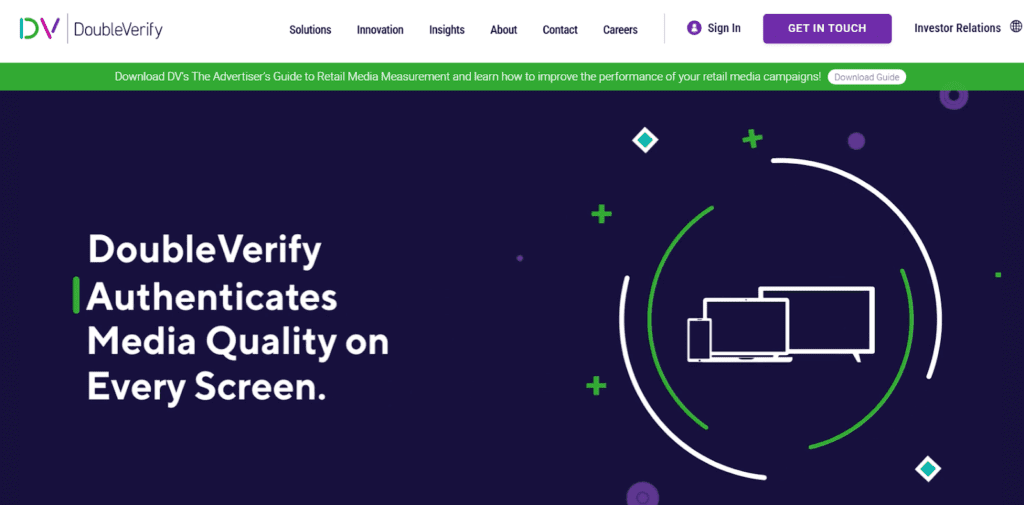
DoubleVerify has supported the world’s largest brands for over a decade. Their verification platform offers viewability, IVT, and brand safety tools that support brands, agencies, marketplaces, publishers, and retail media.
Their mission is to make the digital advertising ecosystem stronger, safer, and more secure. They have a dedicated lab (Fraud Lab) that focuses exclusively on identifying new forms of fraud and developing cutting-edge solutions.
Key features:
- Tailored solutions for all agents involved in the advertising process, from brands to publishers.
- AI-backed deterministic methodology that analyzes impressions and identifies comprehensive fraud and SIVT (sophisticated invalid traffic). They can monitor and block across devices with greater accuracy and fewer false positives.
- A unified service and analytics platform (DV Pinnacle) that offers features based on client needs. Users can access a breakdown of fraud types across devices and performance evaluation.
- Their publisher suite includes viewability insights, invalid traffic detection, brand suitability categories, and video delivery insights.
- Comprehensive yield solutions for publishers that combine data automation, media quality insights, and inventory optimization, whether you use the direct-sold or programmatic method.
Strengths and weaknesses:
| Pros | Cons |
| Accredited by the Media Rating Council (MRC) and received certification from the UK-based ABC (Audit Bureau of Circulations) for Ad Fraud protection. | There can be a steep learning curve when using the tools and no consulting services are provided. |
| Solid reputation. | There is no free plan or version. |
| Demo is available. | No free trial is available. |
| Offers cross-device capabilities. |
Pricing:
Contact DoubleVerify for information on pricing.
2. Fraudlogix
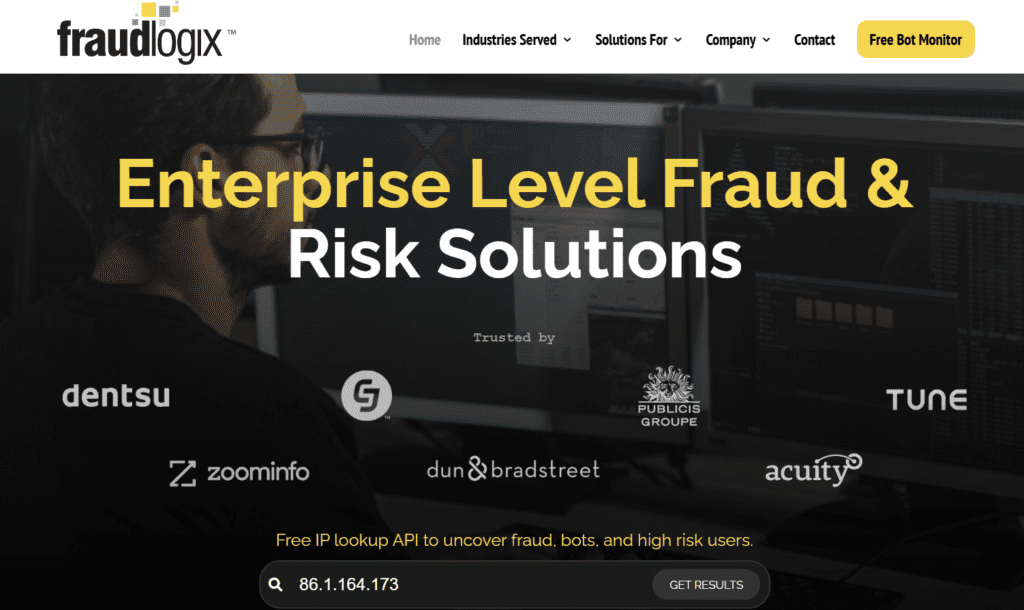
Fraudlogix is an affiliate and ad fraud solutions provider for enterprise traffic quality teams. It offers enterprise-level ad verification and fraud risk management solutions for a variety of brands.
Their solutions target bots, IVT (invalid traffic), click fraud, ad fraud, fake form submissions, fraudulent payments, and cyber-attacks.
Key features:
- Solutions offer security tailored to the specific needs of each industry (cybersecurity, banking, ecommerce, and affiliate marketing). These include a 4-in-1 programmatic solution geared towards brand safety, bot detection, viewability, and domain spoofing.
- Multiple solutions are available to target problems individually: anti-bot measures, IP risk scoring and block listing, and invalid traffic (IVT) solutions.
- Free IP Risk Intelligence API allows businesses to detect and mitigate bots, proxies, VPNs, high-risk users, and fraudulent activities with real-time accuracy.
- Free bot monitor
- Click fraud protection
Strengths and weaknesses:
| Pros | Cons |
| Separate solutions available for each problem—can pick what suits most. | There are no cross-device capabilities. |
| Flat-fee pricing that is available on the website, with no upfront costs. | No social media or mobile app monitoring in the brand protection software. |
| Free version is available, alongside some features, such as a bot monitor. | |
| Company team’s combined experience in ad tech exceeds 50 years; 30 of those focused on detecting ad fraud in all forms. |
Pricing:
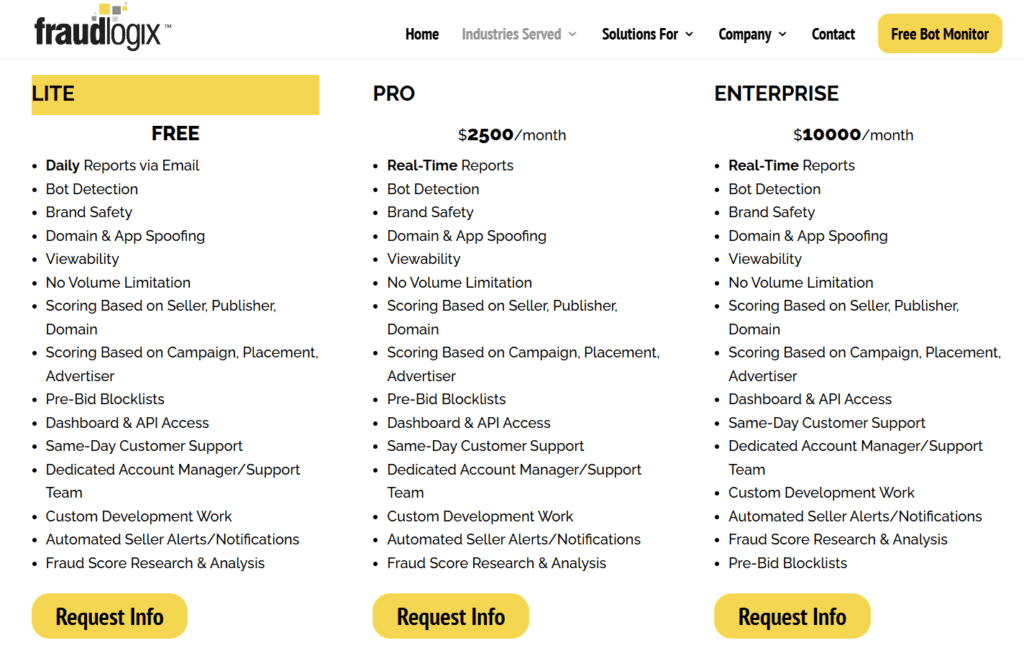
3. Human Security
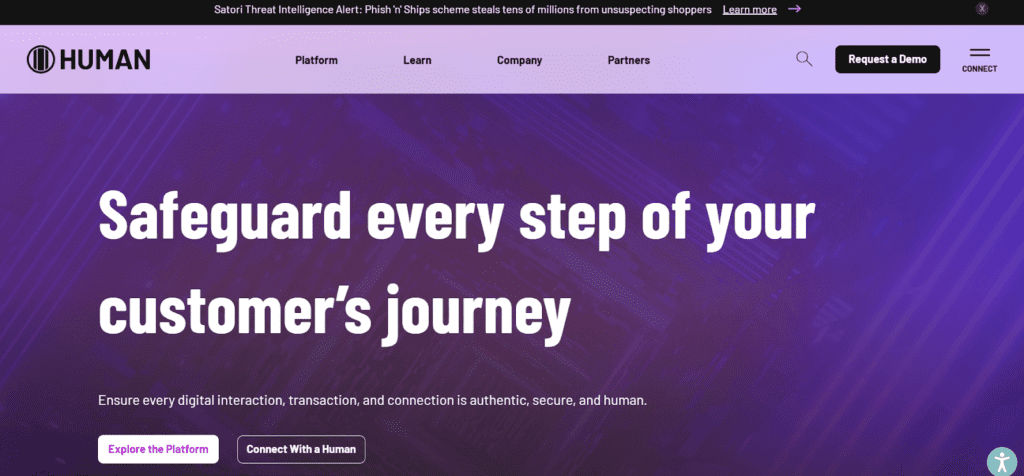
Human Security (formerly White Ops) strives to keep users human and provides protection against ad fraud, malvertising, and has quality standards for platforms and publishers looking to stay secure. They’ve partnered and integrated with tech platforms like AWS and Google Cloud.
Key features:
- A modular platform that offers advertising, application, and account packages with a suite of solutions to prevent, detect, and respond to cyber threats quickly.
- Precheck solution that blocks bots on the first request, before they hit a site.
- Human Challenge, a user-friendly captcha alternative included in the bot management solutions for both web and mobile applications that weeds out bad bots.
- Low-latency technology to ensure bots are stopped with minimal impact on user experience.
- Ad Quality defense solution that prevents unwanted ads by providing visibility into ad quality violations and filters unwanted advertisers and unsuitable or offensive creatives for higher-quality inventory.
- Malvertising defense, which helps to identify and prevent malicious ad behavior and allows you to implement page-level code for automated threat protection to enhance performance without the overhead.
Strengths and weaknesses:
| Pros | Cons |
| Demo is available. | No free trial is available. |
| Operates at a large scale, verifying more than 20 trillion digital interactions weekly across 3 billion unique devices, making it the world’s largest threat network. | There is no free plan or version. |
| Company provides clients with highly accurate data and insights from 400+ algorithms and adaptive machine learning models. | |
| Offers cross-device capabilities. |
Pricing: Contact sales for more information.
Which Brands and Advertisers Use Verification Tech?
Finally, let’s look at some prominent brands and advertisers that use ad verification tech:
- Google: Google offers a range of products for publishers, so it’s only natural they’d have ad verification solutions. The Google Advertiser Verification Program works through Google ads to ensure they only host legitimate campaigns.
- Dentsu: As one of the largest marketing and advertising agencies in the world, Dentsu uses Fraudlogix to perform ad verification and ensure trust and compliance for their clients.
- Amazon: Amazon uses Human Security’s platform in AWS to provide bot protections, prevent fraud and avoid content manipulation.
Conclusion
With countless cyber threats and pages online, manual ad verification is next to impossible. If you really want to safeguard your brand and impression data, you need a solid third-party provider. Consider your company’s needs and start preventing ad fraud today!
